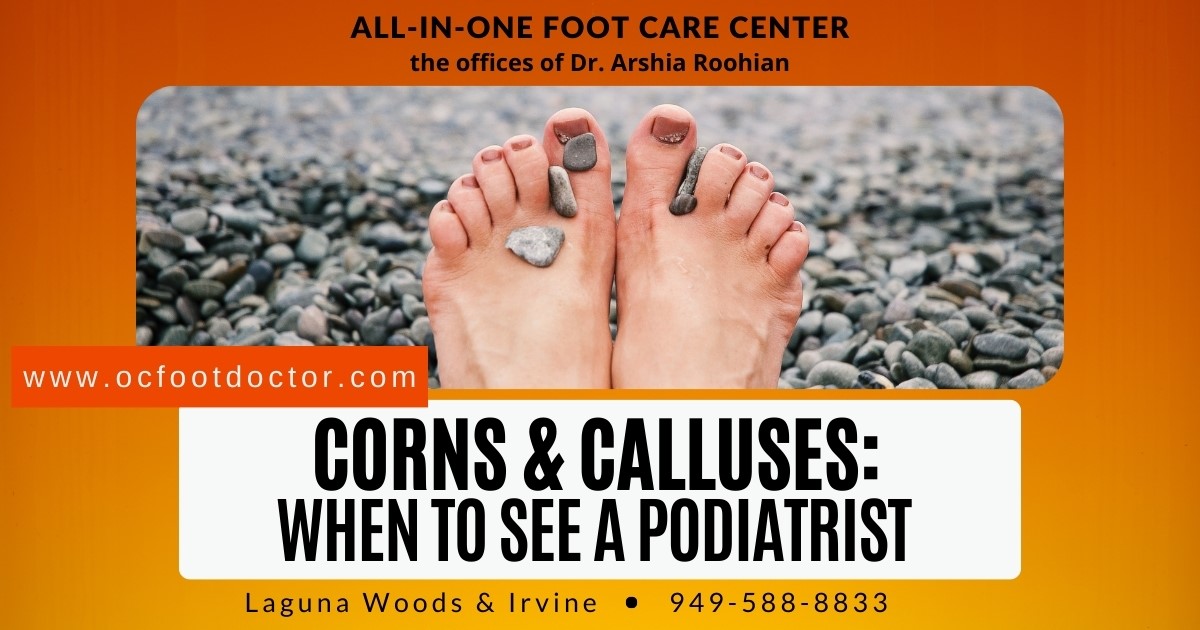Corns & Calluses: When to See a Podiatrist

Today, let's tackle a topic that might ring a bell for many of you – corns and calluses. These common foot concerns can be more than just a cosmetic issue; they can cause discomfort and affect your daily activities. In this blog, we'll delve into what corns and calluses are, how to prevent them, and when it's time to seek the expertise of a podiatrist.
_2.jpg)
Understanding Corns and Calluses: What Are They?
Corns and calluses are thickened, hardened areas of skin that develop in response to repeated friction, pressure, or irritation. While they share similarities, they differ in their location and appearance.
_2.jpg)
Corns:
Usually small, round areas of thickened skin that form on or between the toes. Corns can be painful, especially when pressed.
_3.jpg)
Calluses:
Larger areas of thickened skin that typically develop on the soles of the feet, although they can also appear on the hands or other areas that undergo repetitive friction.
Causes and Risk Factors:
Ill-Fitting Footwear:
Shoes that are too tight or have high heels can cause increased pressure on specific areas of the feet.
Foot Anatomy:
Abnormalities in foot structure, like bunions or hammer toes, can contribute to the development of corns and calluses.
Repetitive Motion:
Certain occupations or activities that involve repetitive motion or pressure on the feet can increase the likelihood of corns and calluses.
Prevention Strategies:
Wear Properly Fitted Shoes:
Choose shoes that provide ample room for your toes and have proper arch support.
Use Protective Padding:
For individuals with foot abnormalities, padding can help distribute pressure more evenly and prevent the formation of corns and calluses.
Keep Feet Moisturized:
Regularly moisturize your feet to prevent dry skin, which can contribute to the formation of calluses.
Avoid Overuse of Corn Plasters:
While over-the-counter corn plasters can be helpful, excessive use can lead to irritation and worsen the problem. Consult with a podiatrist for appropriate treatments.
At-Home Treatment:
Soak and Moisturize:
Soak your feet in warm water to soften the skin, then use a pumice stone to gently exfoliate. Follow up with a moisturizer to keep the skin soft.
Wear Protective Cushions:
Use over-the-counter protective cushions to reduce friction and pressure on corns and calluses.
Avoid Sharp Implements:
Refrain from attempting to cut or shave corns and calluses at home, as this can lead to infection and complications.
_3.jpg)
When to See a Podiatrist:
If you're dealing with persistent or painful corns and calluses, it's time to consult with a podiatrist. Professional care may be necessary for:
Diagnosis and Assessment:
A podiatrist can accurately diagnose the cause of your corns and calluses and assess your foot health comprehensively.
Custom Orthotics:
Custom orthotic inserts may be recommended to alleviate pressure and correct foot mechanics.
Treatment of Underlying Conditions:
Addressing underlying foot conditions, such as bunions or hammertoes, can prevent the recurrence of corns and calluses.
Professional Removal:
A podiatrist can safely and effectively remove thickened skin, providing relief from pain and discomfort.
Remember, your feet deserve the best care. If corns and calluses are causing you distress, don't hesitate to reach out to a podiatrist for personalized advice and treatment. Happy, healthy feet await!


